Characteristics of Organic Phosphorus Pool in Soil of Typical Agriculture Systems in South China
Abstract
1. Introduction
2. Materials and Methods
2.1. Study Area and Soil Collection
2.2. Laboratory Analysis
2.2.1. General Chemical Properties
2.2.2. Soil Organic P Fractions
2.3. Statistical Analysis
3. Results
3.1. Soil Properties
3.2. Soil Total P, Available P and Organic P
3.3. Soil Organic P Fractions
3.3.1. Labile Organic P (LOP)
3.3.2. Moderately Labile Organic P (MLOP)
3.3.3. Moderately Resistant Organic P (MROP)
3.3.4. Highly Resistant Organic P (HROP)
3.4. Proportion of Organic P Fractions in P Pool
3.4.1. Proportion of Total Organic P to Total P
3.4.2. Proportion of Organic P Fractions
3.5. Correlations between Soil Organic P Concentrations and Soil Properties
4. Discussion
5. Conclusions
Supplementary Materials
Author Contributions
Funding
Data Availability Statement
Conflicts of Interest
References
- Jantamenchai, M.; Sukitprapanon, T.S.; Tulaphitak, D. Organic phosphorus forms in a tropical sandy soil after application of organic residues of different quality. Geoderma 2022, 405, 115462. [Google Scholar] [CrossRef]
- Zhang, L.C.; Chen, J.J.; Chu, G. Legacy phosphorus in calcareous soil under 33 years of P fertilizer application: Implications for efficient P management in agriculture. Soil Use Manag. 2022, 38, 1380–1393. [Google Scholar] [CrossRef]
- Li, H.; Huang, G.; Meng, Q.; Ma, L.; Yuan, L.; Wang, F. Integrated soil and plant phosphorus management for crop and environment in China. A review. Plant Soil 2011, 349, 157–167. [Google Scholar] [CrossRef]
- Kochian, L.V. Rooting for more phosphorus. Nature 2012, 488, 466–467. [Google Scholar] [CrossRef] [PubMed]
- Zhu, J.; Li, M.; Whelan, M. Phosphorus activators contribute to legacy phosphorus availability in agricultural soils: A review. Sci. Total Environ. 2018, 612, 522–537. [Google Scholar] [CrossRef]
- Dawsonn, C.J.; Hilton, J. Fertiliser availability in a resource-limited world: Production and recycling of nitrogen and phosphorus. Food Policy 2011, 36, 14–22. [Google Scholar] [CrossRef]
- Brady, N.C.; Weil, R.R. The Nature and Properties of Soils; Pearson Education: London, UK, 2017; ISBN 978–0133254488. [Google Scholar]
- Sulieman, S.; Mühling, K.H. Utilization of soil organic phosphorus as a strategic approach for sustainable agriculture. J. Plant Nutr. Soil Sci. 2021, 184, 311–319. [Google Scholar] [CrossRef]
- Wu, Q.H.; Zhang, S.X.; Ren, Y.; Zhan, X.Y.; Xu, M.G.; Feng, G. Soil phosphorus management based on the agronomic critical value of Olsen P. Commun. Soil Sci. Plant Anal. 2018, 49, 934–944. [Google Scholar] [CrossRef]
- Wyngaard, N.; Cabrera, M.L.; Jarosch, K.A.; Bunemann, E.K. Phosphorus in the coarse soil fraction is related to soil organic phosphorus mineralization measured by isotopic dilution. Soil Biol. Biochem. 2016, 12, 107–118. [Google Scholar] [CrossRef]
- Bowman, R.A.; Cole, C.V. An exploratory method for fractionation of organic phosphorus from grassland soil. Soil Sci. 1978, 125, 95–101. [Google Scholar] [CrossRef]
- Condron, L.M.; Newman, S. Revisiting the fundamentals of phosphorus fractionation of sediments and soils. J. Soils Sediments 2011, 11, 830–840. [Google Scholar] [CrossRef]
- Guangzhou Statistical Yearbook. Sown Area and Output of Major Farm Crops and Fruits. 2020. Available online: https://lwzb.gzstats.gov.cn:20001/datav/admin/home/www_nj/2021/directory/content.html?10–15 (accessed on 3 September 2020).
- Dodd, R.J.; Sharpley, A.N. Recognizing the role of soil organic phosphorus in soil fertility and water quality. Resour. Conserv. Recycl. 2015, 105, 282–293. [Google Scholar] [CrossRef]
- Lu, R.K. Analysis Methods of Agricultural Chemistry of Soil; China Agricultural Science and Technology Press: Beijing, China, 2000. [Google Scholar]
- Murphy, J.; Riley, J.P. A modified single solution method for the determination of phosphate in natural waters. Anal. Chim. Acta 1962, 27, 31–36. [Google Scholar] [CrossRef]
- National Soil Census Office. China Soil Census Technology; Agriculture Press: Beijing, China, 1990. [Google Scholar]
- Soil Census Office of Guangdong Province. Guangdong Soil; Science Press: Beijing, China, 1993. [Google Scholar]
- WRB—Word Reference Base for Soil Resources. International Soil Classification System for Naming Soils and Creating Legends for Soil Maps; Food and Agriculture Organization of the United Nations: Rome, Italy, 2014; Volume 106, World Soil Resources Reports. [Google Scholar]
- Lu, F.X. The Pearl River Delta Soil; China Environmental Science Press: Beijing, China, 1988. [Google Scholar]
- Sparks, D.L. Environmental Soil Chemistry, 2nd ed.; Academic Press: New York, NY, USA, 2003. [Google Scholar]
- Xu, P.; Li, Z.; Wang, J. Fertilizer-induced nitrous oxide emissions from global orchards and its estimate of China. Agric. Ecosyst. Environ. 2022, 328, 107854. [Google Scholar] [CrossRef]
- Yan, Z.; Liu, P.; Li, Y. Phosphorus in China’s Intensive Vegetable Production Systems: Overfertilization, Soil Enrichment, and Environmental Implications. J. Environ. Qual. 2013, 42, 982–989. [Google Scholar] [CrossRef]
- Ahmed, W.; Huang, J.; Liu, K. Impacts of long-term inorganic and organic fertilization on phosphorus adsorption and desorption characteristics in red paddies in southern China. PLoS ONE 2021, 16, e0246428. [Google Scholar] [CrossRef]
- National Bureau of Statistics of China. Guangdong Statistical Yearbook of Agriculture 2021; China Statistics Press: Beijing, China, 2021. [Google Scholar]
- Available online: http://dara.gd.gov.cn/gdflzz/content/post_3077919.html (accessed on 3 September 2020).
- Harrison, A.F. Soil Organic Phosphorus, a Review of World Literature; CAB International: Wallingford, UK, 1987. [Google Scholar]
- Maranguit, D.; Guillaume, T.; Kuzyakov, Y. Land-use change affects phosphorus fractions in highly weathered tropical soils. Catena 2017, 149, 385–393. [Google Scholar] [CrossRef]
- Wu, L.L.; Liu, X.Q.; Zhang, Z.X. Forms and Avaliability of Phosphorus in Typical Soil of Jilin Province. Acta Agric. Boreali-Occident. Sin. 2021, 30, 737–745. [Google Scholar]
- Qi, P.; Wang, X.J.; Jiao, Y.P. Effects of phosphorus application on phosphorus composition and availability of spring wheat topsoil on the Loess Plateau of Longzhong. Agric. Res. Arid Areas 2021, 39, 99–106. [Google Scholar]
- Saleque, M.A.; NaheU, A.; Islam, A. Inorganic and Organic Phosphorus Fertilizer Effects on the Phosphorus Fractionation in Wetland Rice Soils. Soil Sci. Soc. Am. 2004, 68, 1635–1644. [Google Scholar] [CrossRef]
- Zhang, H.; Kovar, J.L. Fractionation of soil phosphorus. In Methods of Phosphorus Analysis for Soils, Sediments, Residuals, and Waters; Kovar, J.L., Pierzynski, G.M., Eds.; Virginia Tech University: Blacksburg, VA, USA, 2009; Volume 2, pp. 50–60. [Google Scholar]
- Appelhans, S.C.; Barbagelata, P.A.; Melchiori, R.J.M. Assessing soil P fractions changes with long-term phosphorus fertilization related to crop yield of soybean and maize. Soil Use Manag. 2020, 36, 524–535. [Google Scholar] [CrossRef]
- Wang, Z.R.; Niu, D.C.; Hu, Y.G. Changes in soil phosphorus fractions associated with altered vegetation and edaphic conditions across a chronosequence of revegetated dunes in a desert area. Geoderma 2022, 424, 115995. [Google Scholar] [CrossRef]
- Cabreira, W.V.; Pereira, M.G.; Carvalho, B.F. Soil organic phosphorus (P) increases in mixed plantations of Acacia mangium and Eucalyptus urograndis in Planosol from Brazil. Trees 2022, 36, 1017–1027. [Google Scholar] [CrossRef]
- Sharpley, A.N.; Smith, S.J. Fractionation of Inorganic and Organic Phosphorus in Virgin and Cultivated Soils. Soil Sci. Soc. Am. J. 1985, 49, 127–130. [Google Scholar] [CrossRef]
- Xu, C.; Shen, S.; He, Z.; Wang, N.; Zhou, B.; Shen, M.; Shi, L.; Xue, L. Effects of long-term application of inorganic phosphate fertilizer to soil phosphorus pools in yellow soil paddy fields. J. Agro Environ. Sci. 2022, 1–13. Available online: https://kns.cnki.net/kcms/detail/12.1347.S.20220520.1440.002.html (accessed on 23 May 2022).
- Sunita, G.; Singh, Y.V. Soil organic phosphorus fractions in response to long-term fertilization with composted manures under rice-wheat cropping system. J. Plant Nutr. 2016, 39, 1336–1347. [Google Scholar] [CrossRef]
- Yang, C.; Yang, L.; Lee, J. Organic Phosphorus Fractions in Organically Amended Paddy Soils in Continuously and Intermittently Flooded Conditions. J. Environ. Qual. 2006, 35, 1142–1150. [Google Scholar] [CrossRef]
- Schaefer, C.E.G.R.; Fabris, J.D.; Ker, J.C. Minerals in the clay fraction of Brazilian Latosols (Oxisols): A review. Clay Min. 2008, 43, 137–154. [Google Scholar] [CrossRef]
- He, J.; Du, L.; Cheng, Z. Influence of tillage practices on phosphorus forms in aggregates of Mollisols from northeast China. J. Sci. Food Agric. 2021, 101, 4523–4531. [Google Scholar] [CrossRef]
- Danilo, S.R.; Ibanor, A. Accumulation of soil organic phosphorus by soil tillage and cropping systems under subtropical conditions. Commun. Soil Sci. Plant Anal. 2003, 34, 2339–2354. [Google Scholar]
- Li, M.; Zhang, J.; Wang, G. Organic phosphorus fractionation in wetland soil profifiles by chemical extraction and phosphorus-31 nuclear magnetic resonance spectroscopy. Appl. Geochem. 2013, 33, 213–221. [Google Scholar] [CrossRef]
- Yu, X.; Tong, D.; Wang, S. Long-term rice cultivation promoted microbial mineralization of organic P in a black soil. Soil Sci. Soc. Am. J. 2022, 86, 540–551. [Google Scholar] [CrossRef]
- Ringeval, B.; Nowak, B.; Nesme, T.; Delmas, M.; Pellerin, S. Contribution of anthropogenic phosphorus to agricultural soil fertility and food production. Glob. Biogeochem. Cycles 2014, 28, 743–756. [Google Scholar] [CrossRef]
- Tian, X.; Bing, H.; Wu, Y. Farmland abandonment decreases soil bioavailable phosphorus but increases organic phosphorus in the mid-hills of Nepal. Catena 2022, 211, 106000. [Google Scholar] [CrossRef]
- Wang, Y.; Huang, Q.; Gao, H. Long-term cover crops improved soil phosphorus availability in a rain-fed apple orchard. Chemosphere 2021, 275, 130093. [Google Scholar] [CrossRef] [PubMed]
- Hou, E.; Wen, D.; Kuang, Y. Soil pH predominantly controls the forms of organic phosphorus in topsoils under natural broadleaved forests along a 2500 km latitudinal gradient. Geoderma 2018, 315, 65–74. [Google Scholar] [CrossRef]
- Li, S.; Xu, J.; Tang, S. A meta-analysis of carbon, nitrogen and phosphorus change in response to conversion of grassland to agricultural land. Geoderma 2020, 363, 114149. [Google Scholar] [CrossRef]
- Wang, Z.R.; Li, F.R.; Liu, L.L. Changes in soil phosphorus fractions under different land uses in desert grasslands in northwestern China. Eur. J. Soil Sci. 2022, 73, e13255. [Google Scholar] [CrossRef]
- Brucker, E.; Kernchen, S.; Spohn, M. Release of phosphorus and silicon from minerals by soil microorganisms depends on the availability of organic carbon. Soil Biol. Biochem. 2020, 143, 107737. [Google Scholar] [CrossRef]
- Sorkau, E.; Boch, S.; Boeddinghau, R.S. The role of soil chemical properties, land use and plant diversity for microbial phosphorus in forest and grassland soils. J. Soil Sci. Plant Nutr. 2018, 181, 185–197. [Google Scholar] [CrossRef]
- Li, M.; Kang, E.; Wang, J. Phosphorus accumulation poses less influence than soil physicochemical properties on organic phosphorus adsorption on ferrasol. Geoderma 2021, 402, 115324. [Google Scholar] [CrossRef]
- Ning, J.F.; Arenberg, M.; Arai, Y.J. Phosphorus mineralization affected by urea in an intensively managed agricultural soil. Soil Sci. Soc. Am. J. 2021, 85, 2067–2076. [Google Scholar] [CrossRef]
- Ning, J.F.; Arai, Y.J.; Shen, J. Effects of Phosphorus on Nitrification Process in a Fertile Soil Amended with Urea. Agriculture 2021, 11, 523. [Google Scholar] [CrossRef]
- Schleuss, P.M.; Widdig, M.; Heintz-Buschart, A. Interactions of nitrogen and phosphorus cycling promote P acquisition and explain synergistic plant-growth responses. Ecology 2020, 10, e03003. [Google Scholar] [CrossRef]
- Dai, Z.; Liu, G.; Chen, H.; Chen, C.; Wang, J.; Ai, S.; Wei, D.; Li, D.; Ma, B.; Tang, C.; et al. Long-term nutrient inputs shift soil microbial functional profiles of phosphorus cycling in diverse agroecosystems. ISME J. 2020, 14, 757–770. [Google Scholar] [CrossRef]
- Li, H.; Song, C.L.; Cao, X.Y.; Zhou, Y.Y. The phosphorus release pathways and their mechanisms driven by organic carbon and nitrogen in sediments of eutrophic shallow lakes. Sci. Total Environ. 2016, 572, 280–288. [Google Scholar] [CrossRef]
- Chen, S.; Zhang, S.; Yan, Z.; Peng, Y.; Chen, Q. Differences in main processes to transform phosphorus influenced by ammonium nitrogen in flooded intensive agricultural and steppe soils. Chemosphere 2019, 226, 192–200. [Google Scholar] [CrossRef]
- Margalef, O.; Sardans, J.; Fernández-Martínez, M.; Molowny-Horas, R.; Janssens, I.A.; Ciais, P.; Goll, D.; Richter, A.; Obersteiner, M.; Asensio, D.; et al. Global patterns of phosphatase activity in natural soils. Sci. Rep. 2017, 7, 1337. [Google Scholar] [CrossRef]
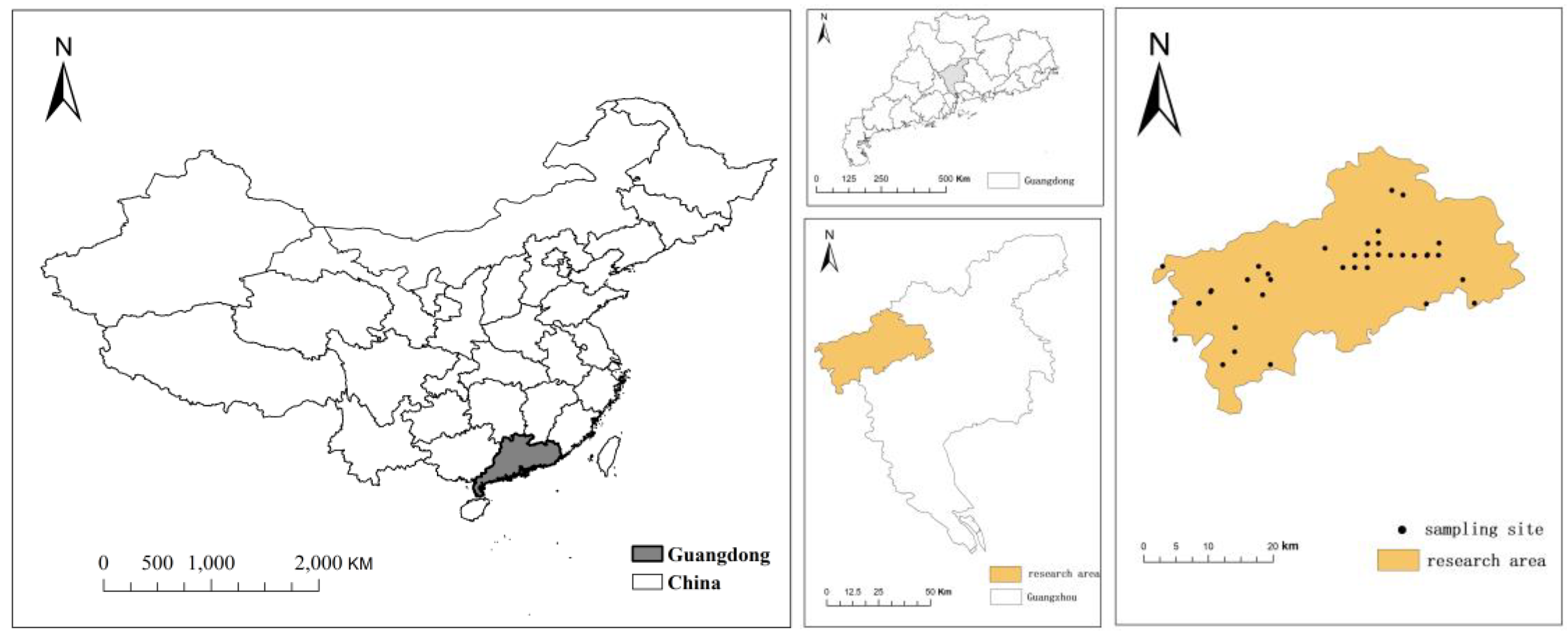



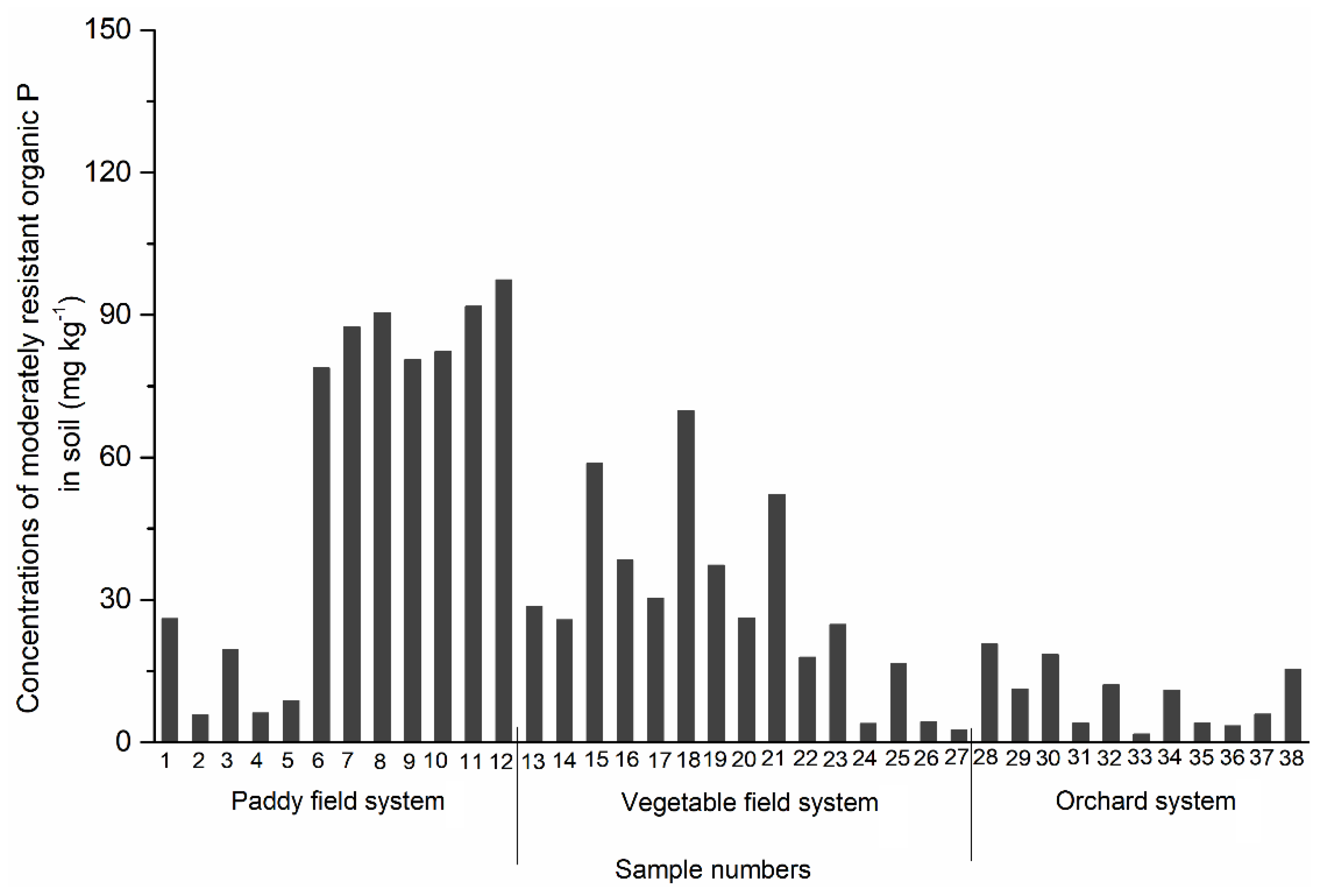
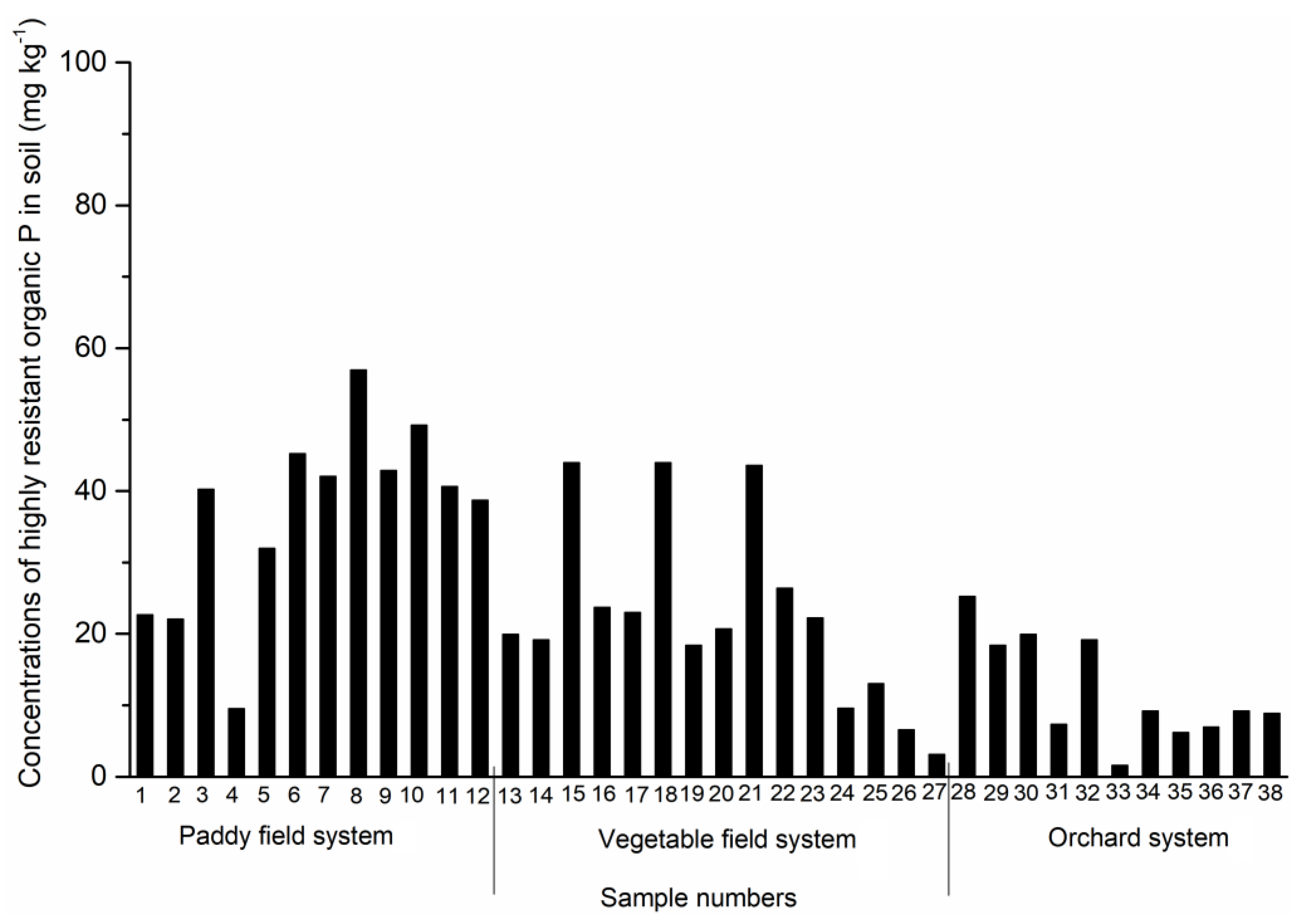
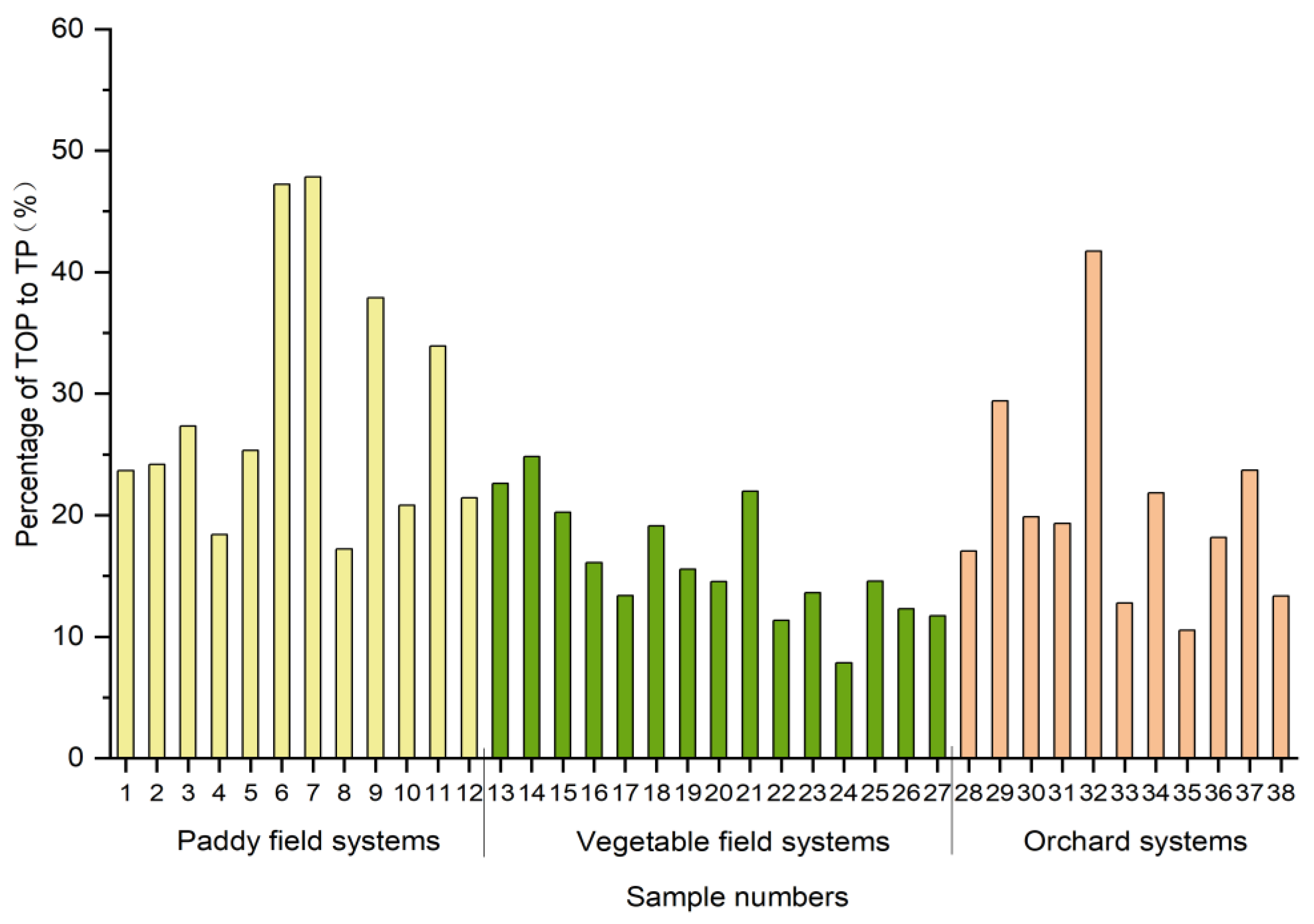

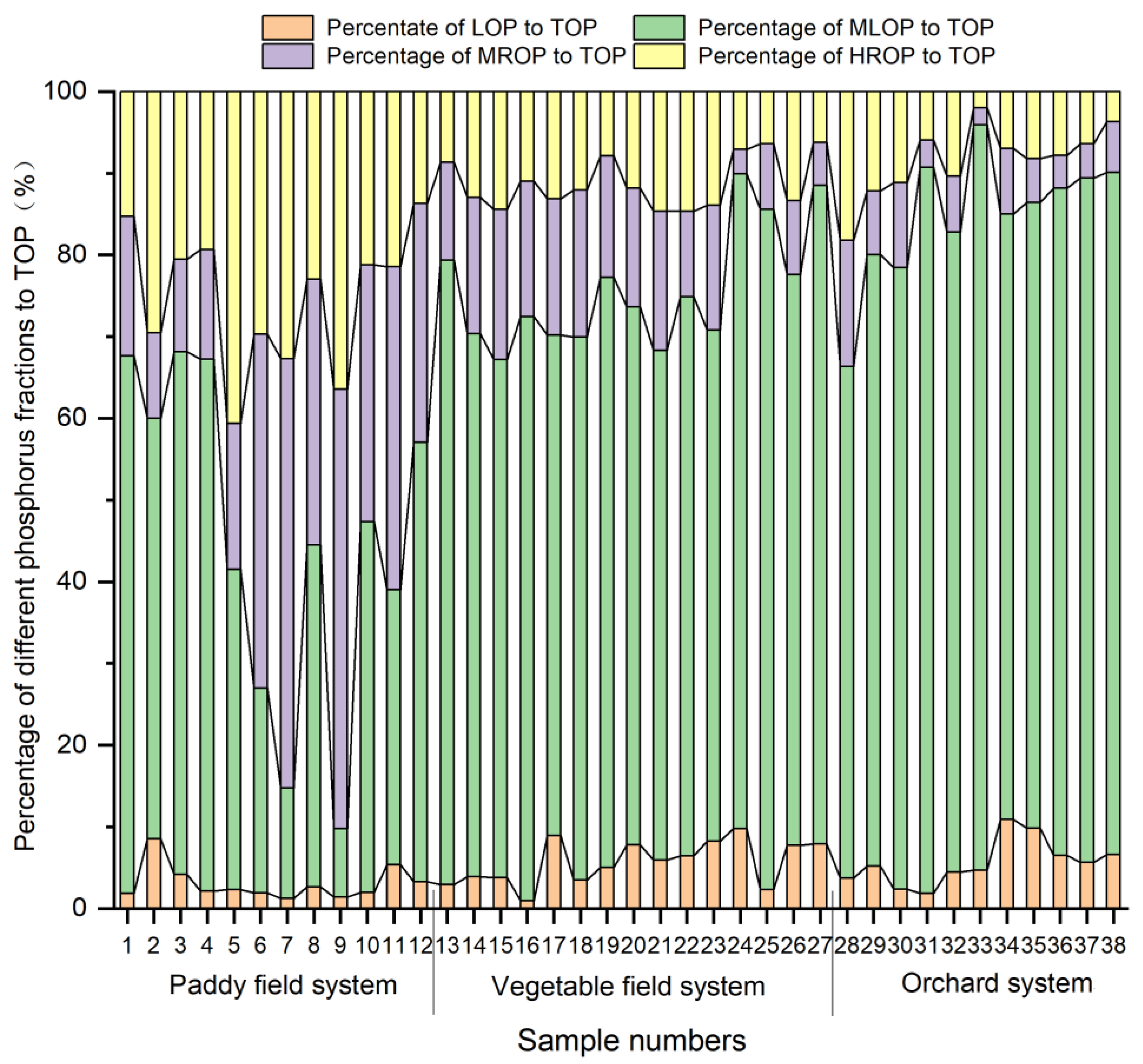
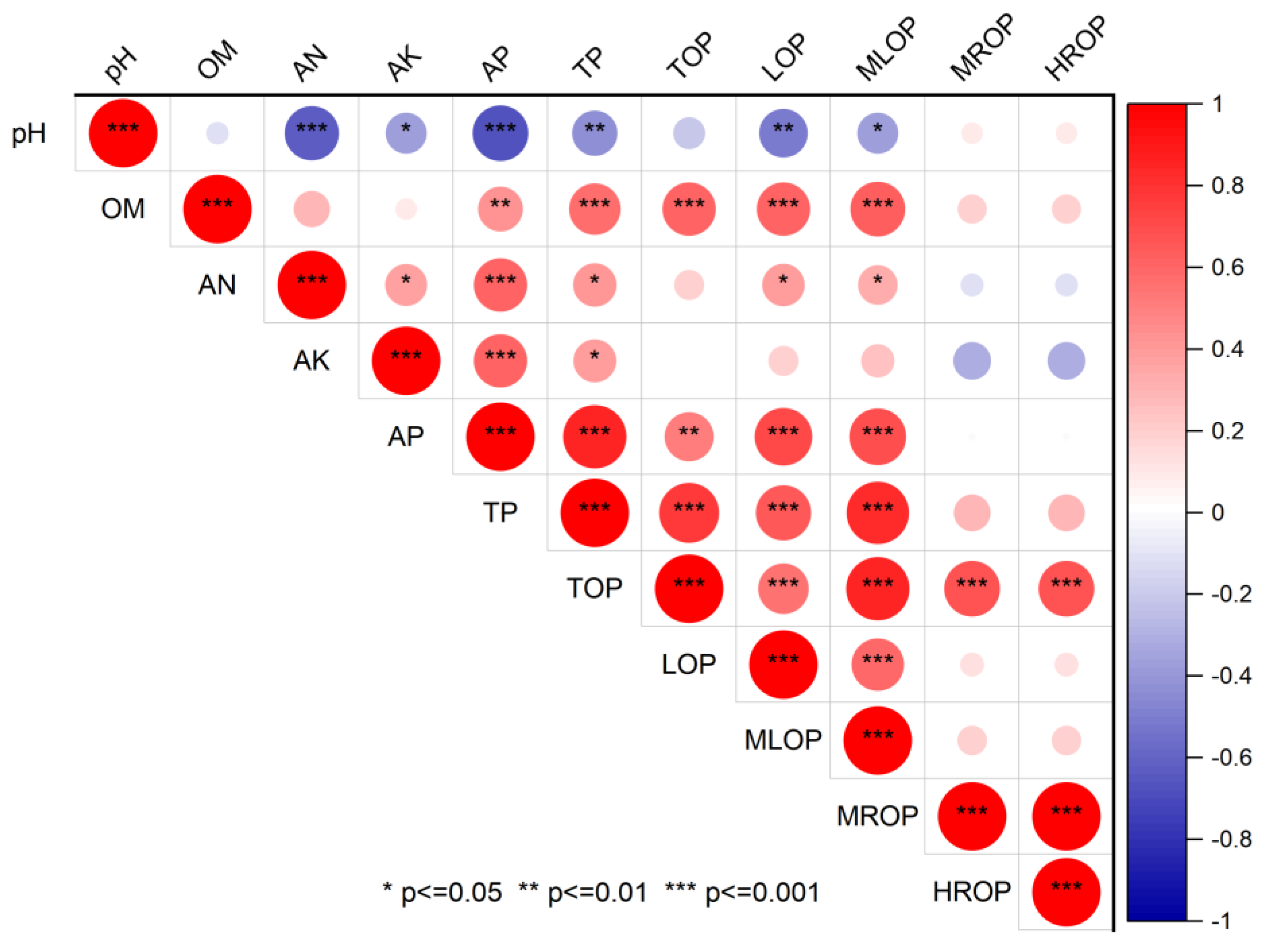
| Planting System | Parameters | pH | Organic Matter (OM) (g·kg−1) | Available N (AN) (mg·kg−1) | Available K (AK) (mg·kg−1) |
|---|---|---|---|---|---|
| Paddy field | Mean | 6.47 | 16.12 | 76.29 | 87.43 |
| Range | 5.32–7.90 | 9.77–25.41 | 33.53–123.42 | 58.61–149.04 | |
| C.V.(%) | 13.51 | 32.59 | 39.97 | 31.08 | |
| Vegetable field | Mean | 5.32 | 18.89 | 114.8 | 173.14 |
| Range | 3.98–6.91 | 9.12–30.26 | 61.16–152.53 | 50.17–291.75 | |
| C.V.(%) | 14.66 | 30.18 | 23.02 | 38.79 | |
| Orchard | Mean | 5.48 | 20.01 | 119.8 | 160.83 |
| Range | 3.79–7.16 | 9.07–29.78 | 54.53–249.79 | 63.32–312.17 | |
| C.V.(%) | 14.66 | 30.18 | 23.02 | 38.79 |
Publisher’s Note: MDPI stays neutral with regard to jurisdictional claims in published maps and institutional affiliations. |
© 2022 by the authors. Licensee MDPI, Basel, Switzerland. This article is an open access article distributed under the terms and conditions of the Creative Commons Attribution (CC BY) license (https://creativecommons.org/licenses/by/4.0/).
Share and Cite
Li, T.; Yao, J.; Zeng, R.; Chen, Y.; Hu, L.; Zou, M.; Ning, J. Characteristics of Organic Phosphorus Pool in Soil of Typical Agriculture Systems in South China. Horticulturae 2022, 8, 1055. https://doi.org/10.3390/horticulturae8111055
Li T, Yao J, Zeng R, Chen Y, Hu L, Zou M, Ning J. Characteristics of Organic Phosphorus Pool in Soil of Typical Agriculture Systems in South China. Horticulturae. 2022; 8(11):1055. https://doi.org/10.3390/horticulturae8111055
Chicago/Turabian StyleLi, Tong, Jianwu Yao, Ruikun Zeng, Yong Chen, Lijiang Hu, Mengyao Zou, and Jianfeng Ning. 2022. "Characteristics of Organic Phosphorus Pool in Soil of Typical Agriculture Systems in South China" Horticulturae 8, no. 11: 1055. https://doi.org/10.3390/horticulturae8111055
APA StyleLi, T., Yao, J., Zeng, R., Chen, Y., Hu, L., Zou, M., & Ning, J. (2022). Characteristics of Organic Phosphorus Pool in Soil of Typical Agriculture Systems in South China. Horticulturae, 8(11), 1055. https://doi.org/10.3390/horticulturae8111055






